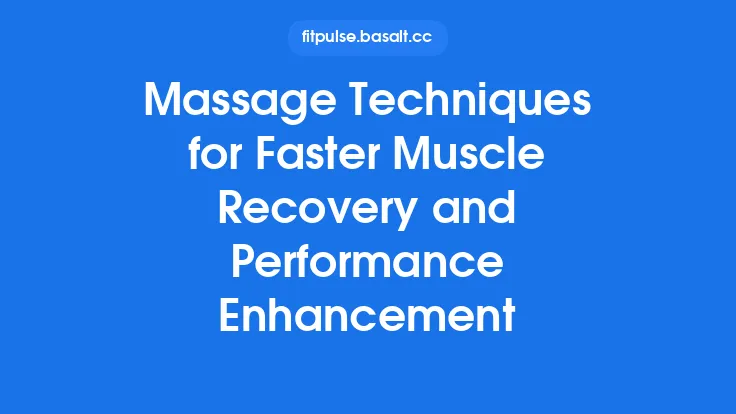Percussive therapy devices have surged in popularity among athletes, physical therapists, and fitness enthusiasts alike, promising faster muscle recovery, reduced soreness, and improved range of motion. While the market is flooded with a variety of gadgets, understanding the science behind these tools, how to select the right one, and how to incorporate them safely into a recovery regimen can make the difference between a fleeting trend and a truly effective therapeutic ally.
How Percussive Therapy Works
At its core, percussive therapy—often referred to as “vibration therapy” or “muscle tapping”—delivers rapid, high‑amplitude pulses of pressure to soft tissue. The device’s motor drives a piston or cam that translates rotary motion into linear strokes, creating a series of short, forceful impacts that travel through the attachment head and into the underlying muscle fibers. Typical stroke frequencies range from 1,200 to 3,200 per minute (20–53 Hz), while amplitudes can vary between 8 mm and 16 mm, depending on the model.
These mechanical impulses generate several physiological responses:
- Mechanical Deformation of Tissue – The rapid compression and release stretch muscle fibers, fascia, and connective tissue, promoting fluid exchange and reducing adhesions.
- Neuromuscular Stimulation – The high‑frequency taps activate mechanoreceptors (e.g., Pacinian corpuscles) and muscle spindles, which can modulate pain pathways via the gate control theory.
- Enhanced Blood Flow – The repetitive pressure wave creates a “muscle pump” effect, encouraging venous return and arterial inflow, which accelerates the delivery of oxygen and nutrients while facilitating metabolic waste removal.
- Metabolic Activation – Localized vibration can increase the activity of enzymes involved in ATP regeneration, supporting quicker replenishment of energy stores in fatigued fibers.
Collectively, these mechanisms help to alleviate delayed onset muscle soreness (DOMS), improve tissue pliability, and prepare muscles for subsequent training sessions.
Key Components and Technology
| Component | Function | Typical Specs |
|---|---|---|
| Motor | Generates the driving force for the piston; high‑torque brushless DC motors are common for durability and quiet operation. | 30–60 W, 12,000–20,000 rpm |
| Piston/Drive Shaft | Converts rotary motion into linear strokes; often made of hardened steel or aluminum for longevity. | Stroke length 8–16 mm |
| Amplitude Control | Allows users to adjust the depth of each impact, tailoring intensity to body part and tolerance. | 0–16 mm (adjustable) |
| Speed Settings | Provides a range of frequencies; some devices offer continuous variable speed, while others have preset levels. | 1,200–3,200 spm (or 20–53 Hz) |
| Attachment Heads | Interchangeable tips (ball, flat, fork, bullet, etc.) that focus the force on specific muscle groups or trigger points. | Silicone‑coated, stainless steel, or polymer |
| Battery & Power Management | Lithium‑ion packs deliver several hours of use; smart power management prevents overheating. | 2–4 hours continuous, 10–15 hours standby |
| User Interface | LCD or LED display for speed, battery, and mode; some models integrate Bluetooth for app‑based tracking. | Touchscreen, rotary dial, or button matrix |
Advanced models may incorporate additional sensors—such as accelerometers for stroke consistency, temperature monitoring for skin safety, or even EMG feedback to guide treatment intensity.
Physiological Effects on Muscle Tissue
1. Micro‑circulatory Enhancement
The pulsatile pressure creates shear stress on endothelial cells lining capillaries, stimulating nitric oxide release. This vasodilatory response expands micro‑vessels, improving perfusion. Studies using Doppler ultrasound have documented a 15–30 % increase in blood flow to treated muscles within minutes of a 5‑minute percussive session.
2. Fascial Remodeling
Fascia, the connective tissue sheath surrounding muscles, can become stiff or develop adhesions after repetitive loading. The high‑frequency impacts mechanically separate fascial layers, encouraging a more organized collagen alignment. Over time, this can translate to increased joint range of motion and reduced risk of strain.
3. Neuromodulation of Pain
Activation of large‑diameter afferent fibers (A‑β) competes with nociceptive signals carried by smaller C‑fibers, diminishing the perception of pain. This effect is comparable to the analgesic benefits observed with traditional massage, but with the added advantage of precise, repeatable dosing.
4. Metabolic Clearance
Enhanced circulation accelerates the removal of lactate, hydrogen ions, and inflammatory cytokines (e.g., IL‑6, TNF‑α). By reducing the local concentration of these metabolites, percussive therapy can shorten the recovery window between high‑intensity bouts.
5. Motor Unit Recruitment
Brief, high‑intensity vibrations can “prime” motor neurons, leading to more efficient recruitment patterns during subsequent activity. This neuromuscular priming is especially valuable for athletes seeking to improve explosive performance after a recovery period.
Benefits for Different Athlete Populations
| Athlete Type | Primary Recovery Challenge | How Percussive Therapy Helps |
|---|---|---|
| Endurance Runners | Cumulative muscle fatigue, calf tightness | Improves calf and hamstring circulation, reduces DOMS after long runs |
| Strength Lifters | Localized soreness, trigger points in large muscle groups | Deep penetration of high‑amplitude strokes alleviates tightness in quads, glutes, and back |
| Team Sport Players (soccer, basketball) | Multi‑joint strain, rapid turnover of training sessions | Quick, portable treatment between drills; enhances joint mobility |
| Rehabilitation Patients | Post‑injury scar tissue, limited range of motion | Facilitates fascial glide and soft‑tissue remodeling without excessive load |
| Older Adults & Masters Athletes | Slower tissue repair, decreased elasticity | Low‑intensity settings improve circulation without stressing fragile tissues |
Because the devices are adjustable, the same unit can be calibrated to meet the unique needs of each group, making percussive therapy a versatile component of a comprehensive recovery toolbox.
Choosing the Right Device
When evaluating percussive therapy devices, consider the following criteria:
- Amplitude Range – Higher amplitudes (≥12 mm) are better for deep muscle groups (e.g., glutes, hamstrings), while lower amplitudes suit delicate areas (e.g., neck, forearms).
- Speed Flexibility – Devices offering a continuous speed dial allow fine‑tuning; preset levels may be sufficient for beginners.
- Attachment Variety – A robust set of heads (ball, flat, fork, thumb) expands the device’s utility across the body.
- Battery Life & Charging – For on‑the‑go athletes, a minimum of 2 hours of continuous use and fast‑charge capability are essential.
- Ergonomics – A well‑balanced, lightweight body reduces user fatigue during prolonged sessions.
- Noise Level – Brushless motors typically operate below 55 dB, making them suitable for gym or home use without disturbing others.
- Warranty & Service – Look for at least a 2‑year warranty covering motor and battery, plus readily available replacement parts.
Professional reviews and peer‑reviewed studies can provide insight into real‑world performance, but personal trial (many retailers offer demo units) remains the gold standard for fit‑for‑purpose selection.
Proper Usage Protocols
Pre‑Treatment Preparation
- Hydration: Adequate fluid intake supports vascular response.
- Warm‑up (optional): Light aerobic activity (5–10 min) can increase baseline blood flow, enhancing the device’s effect.
- Skin Check: Ensure the treatment area is free of open wounds, rashes, or excessive hair that could cause discomfort.
Treatment Parameters
| Parameter | Recommended Range | Rationale |
|---|---|---|
| Duration per Muscle Group | 30 seconds – 2 minutes | Sufficient to stimulate circulation without overstimulation |
| Frequency (Speed) | 1,800–2,400 spm (30–40 Hz) for general recovery; 2,800–3,200 spm (45–53 Hz) for neuromuscular priming | Balances depth of penetration with comfort |
| Amplitude | 10–12 mm for large muscles; 8–10 mm for smaller or sensitive areas | Adjusts impact depth to tissue thickness |
| Rest Intervals | 15–30 seconds between muscle groups | Allows local blood flow to normalize |
Technique Tips
- Glide vs. Stationary: For large muscle bellies, a slow glide (1–2 cm/s) distributes energy evenly. For trigger points, hold the head stationary over the knot for 10–15 seconds before moving.
- Angle of Contact: Maintain the attachment head perpendicular to the skin to maximize force transmission.
- Pressure Control: Let the device’s weight provide the primary force; avoid excessive manual pressure, which can diminish the percussive effect and increase discomfort.
Post‑Treatment
- Stretching: Gentle static stretching (15–30 seconds) after treatment can lock in increased range of motion.
- Hydration & Nutrition: Replenish electrolytes and protein to support metabolic recovery.
- Documentation: If using a device with app integration, log session parameters to track progress and adjust future protocols.
Safety Considerations and Contraindications
While percussive therapy is generally safe, certain conditions warrant caution or avoidance:
- Acute Injuries: Do not apply to fresh bruises, fractures, or severe sprains until cleared by a medical professional.
- Neuropathy or Sensory Deficits: Reduced sensation can mask excessive pressure, increasing risk of tissue damage.
- Implanted Devices: Individuals with pacemakers, insulin pumps, or other electronic implants should consult a physician, as high‑frequency vibrations may interfere with device function.
- Pregnancy: Avoid abdominal and lower back treatment unless approved by an obstetrician.
- Thrombosis or Vascular Disorders: The increased blood flow could dislodge clots; medical clearance is essential.
- Skin Conditions: Open wounds, eczema, psoriasis, or severe dermatitis should be left untreated to prevent irritation.
General safety tips:
- Start with the lowest intensity and gradually increase as tolerance builds.
- Keep the device moving; prolonged static pressure can cause bruising.
- Use only manufacturer‑approved attachment heads to ensure proper force distribution.
- Periodically inspect the device for wear, especially the piston and motor housing.
Maintenance and Longevity
- Cleaning: Wipe the attachment heads with a mild disinfectant after each use. Avoid submerging the motor housing in liquids.
- Battery Care: Follow the manufacturer’s charging cycle—most lithium‑ion packs benefit from partial discharges (20–80 %) rather than full cycles. Store the device in a cool, dry place when not in use.
- Lubrication (if applicable): Some high‑end models have serviceable pistons that require periodic oiling; refer to the service manual.
- Firmware Updates: For Bluetooth‑enabled units, install software updates to improve performance and add new treatment programs.
- Inspection: Check for loose screws, abnormal noises, or vibration irregularities monthly. Early detection of motor wear can prevent catastrophic failure.
A well‑maintained percussive device can provide reliable performance for 3–5 years, making it a cost‑effective investment in long‑term recovery.
Integrating Percussive Therapy into a Recovery Routine
A holistic recovery plan blends multiple modalities—nutrition, sleep, active recovery, and targeted therapies. Percussive therapy fits naturally into this ecosystem:
- Post‑Workout (Immediate): 1–2 minutes per major muscle group at moderate intensity to accelerate lactate clearance.
- Mid‑Day (Active Recovery): Light‑intensity sessions (30 seconds per area) to maintain circulation during sedentary periods.
- Pre‑Competition (Priming): High‑frequency, short‑duration bursts on key power muscles (e.g., calves, quadriceps) to enhance neuromuscular readiness.
- Evening (Relaxation): Low‑intensity, longer‑duration strokes combined with gentle stretching to promote parasympathetic activation and improve sleep quality.
When paired with other evidence‑based practices—such as adequate protein intake, sleep hygiene, and periodized training—percussive therapy can help athletes sustain higher training volumes while minimizing injury risk.
Emerging Trends and Future Directions
1. Smart Adaptive Algorithms
Machine‑learning models are being integrated into device firmware to automatically adjust speed and amplitude based on real‑time feedback from built‑in accelerometers and surface EMG sensors. This “closed‑loop” approach aims to deliver the optimal dose of vibration for each individual’s tissue characteristics.
2. Hybrid Modalities
Manufacturers are experimenting with combining percussive impact with other therapeutic energies, such as infrared LEDs or low‑level electrical stimulation, to create multi‑modal recovery tools that address both mechanical and cellular pathways simultaneously.
3. Wearable Percussive Pods
Miniaturized percussive units that can be strapped to limbs for continuous low‑level vibration during sleep or passive recovery are under development. Early prototypes suggest potential benefits for overnight muscle perfusion without disrupting rest.
4. Data Integration with Training Platforms
API connections to popular training apps (e.g., Strava, TrainingPeaks) enable automatic logging of recovery sessions, allowing coaches to correlate percussive therapy usage with performance metrics and adjust training loads accordingly.
5. Clinical Validation
Large‑scale, randomized controlled trials are being launched to quantify the impact of percussive therapy on injury rates, performance output, and long‑term musculoskeletal health. Results from these studies will shape evidence‑based guidelines for both elite and recreational athletes.
Frequently Asked Questions
Q: How does percussive therapy differ from traditional massage?
A: While both aim to improve tissue quality, percussive therapy delivers rapid, high‑amplitude impacts that can reach deeper muscle layers more consistently than manual pressure. It also offers quantifiable settings (speed, amplitude) and repeatable dosing.
Q: Can I use a percussive device on joints?
A: Yes, but with caution. Use low‑intensity settings and attachment heads designed for joint work (e.g., flat or fork). Avoid direct impact on cartilage surfaces; focus on surrounding musculature.
Q: Is there an optimal time of day for treatment?
A: The device is effective at any time, but many athletes find it most beneficial immediately post‑exercise for metabolic clearance, and pre‑competition for neuromuscular priming.
Q: How long will a typical session last?
A: For general recovery, 10–15 minutes total (covering major muscle groups) is sufficient. Targeted sessions for trigger points may be as short as 2–3 minutes.
Q: Will regular use make me dependent on the device?
A: No. Percussive therapy facilitates natural physiological processes (circulation, tissue remodeling). Over time, improved tissue health may reduce the frequency of required sessions.
Conclusion
Percussive therapy devices have evolved from niche gadgets into scientifically grounded tools that address the core challenges of muscle recovery: inflammation, stiffness, and metabolic waste accumulation. By delivering controlled, high‑frequency mechanical impulses, they stimulate circulation, modulate pain pathways, and promote fascial mobility—all essential components of an effective regeneration strategy.
Choosing a device that matches your performance goals, mastering proper technique, and integrating the therapy into a balanced recovery regimen can yield measurable gains in soreness reduction, range of motion, and readiness for the next training session. As technology continues to advance—bringing smarter algorithms, hybrid modalities, and deeper data integration—the future of percussive therapy promises even more precise, personalized, and efficient pathways to optimal muscle health.





